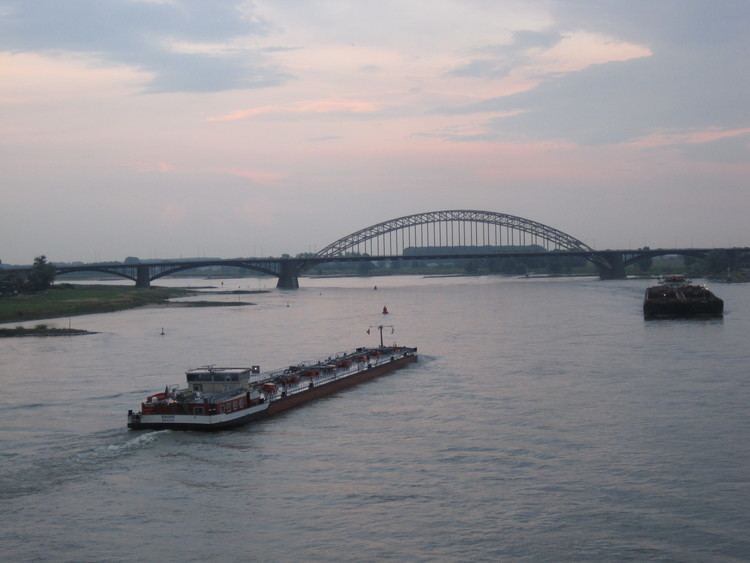Discharge 1,500 m³/s | Length 80 km | |
 | ||
- average 1,500 m/s (52,972 cu ft/s) Sources Millingen aan de Rijn, Rhine | ||
The Waal or Rivier Waal ("Waal River") is the main distributary branch of river Rhine flowing through the Netherlands. Approximately 80 km (50 mi), it is the major waterway connecting the port of Rotterdam to Germany. Before it reaches Rotterdam, it joins with the Afgedamde Maas near Woudrichem to form the Boven Merwede. Along its length, Nijmegen, Tiel, Zaltbommel and Gorinchem are towns of importance with direct access to the river.
Contents
- Map of Waal Netherlands
- HistoryEdit
- Bend in South HollandEdit
- Railroad bridgesEdit
- Water qualityEdit
- References
Map of Waal, Netherlands
The river, which is the main channel in the Rhine–Meuse–Scheldt delta system, carries 65% of the total flow of the Rhine.
HistoryEdit
In 1915, a perfectly preserved iron and bronze Roman cavalry helmet, known as the Nijmegen Helmet, was uncovered on the left bank of the Waal in Nijmegen.
The name Waal, in Roman times called Vacalis, Vahalis or Valis, later Vahal, is of Germanic origin and is named after the many meanders in the river (Old Germanic: wôh = crooked). It is, in turn, thought to have inspired early Dutch settlers of the Hudson Valley region in New York to name the Wallkill River after it (Waalkil = "Waal Creek").
The current river shows little signs of these great bends, since the river has been the subject of numerous normalisation projects carried out in the 18th, 19th and 20th centuries to improve the river as an economically important shipping route. Some of the cut-off bends are still visible near the main river and are sometimes reconnected to it in times of high water levels.
Bend in South HollandEdit
In the Middle Ages, the name "Waal" continued after the confluence with River Meuse. The delta parts now known as Boven Merwede, Beneden Merwede and the upper section of river Noord were also called Waal. Near Hendrik-Ido-Ambacht, the main stream continued west until it flowed into River Oude Maas near Heerjansdam. This last stretch past Hendrik-Ido-Ambacht, which separates the river islands of IJsselmonde and Zwijndrechtse Waard, still is called Waal, but is more commonly known as Waaltje (Dutch for Little Waal). It has been dammed off at both ends.
Railroad bridgesEdit
Railroad bridges (with nearest train station on the left and right bank):
Water qualityEdit
The Waal has significant adverse water quality due to discharge of raw sewage by France and Germany. A number of pathogens have been monitored to occur in the river waters from such sewage.
